Semiconductor Spin Qubits
Explore our scope of research and research highlights
Research scope
Electron and hole spins in solid-state nano-structures possess unique properties with favourably long spin coherence, and the ability to implement fast coherent control with optical, magnetic and electric fields. The major challenge we address in our studies is the realisation of spin qubits with milliseconds-range coherence, and the development of optical and microwave control techniques enabling fast electron spin control in semiconductor quantum dots (QDs). In group III-V semiconductor nano-structures the dominant mechanism of spin qubit information loss (decoherence) is magnetic interaction with the fluctuating nuclear spin ensemble of the crystal lattice. In our experimental research we explore strategies for controlling the mesoscopic nuclear spin ensembles, turning them into a quantum information resource. Development of new nuclear magnetic resonance (NMR) techniques enables non-invasive structural studies of semiconductor quantum dots, coherent control of the nuclear spin quantum states, and exploration of unusual collective many-body quantum effects.
Please contact Dr Evgeny Chekhovich (e.chekhovich@sussex.ac.uk) for any enquiries.
Research highlights
Towards 100% nuclear spin polarization in a solid
It is well known that by polarizing the nuclear spins in a quantum dot it is possible to eliminate decoherence of the electron spin qubit, while turning the nuclei into a useful quantum information resource. Although conceptually simple, achieving nuclear polarizations close to 100% in a semiconductor has remained an evasive goal for many decades. We solve this problem with a spin polarization protocol which combines strong optical pumping and fast electron tunnelling, resulting for the first time in nuclear polarizations well above 95%, achieved in GaAs/AlGaAs semiconductor quantum dots. The technique is compatible with standard quantum dot device designs, where highly-polarized nuclear spins can simplify implementations of qubits and quantum memories, as well as offer a testbed for studies of many-body quantum dynamics at near-zero spin temperatures.
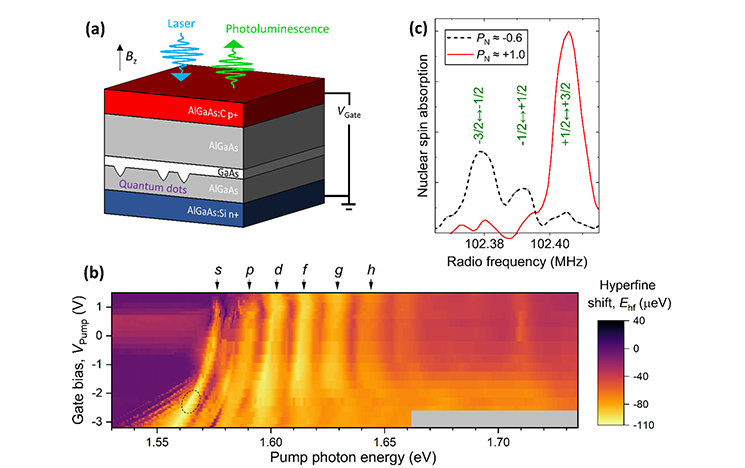
(a) Semiconductor device with gated (charge-tuneable) epitaxial GaAs/AlGaAs quantum dots. (b) Optimization of nuclear spin polarization at variable sample gate bias and optical pumping photon energy. Dashed circle shows optimal polarization conditions achieved at large reverse bias and under optical pumping of the s-shell quantum dot exciton. (c) Nuclear magnetic resonance (NMR) spin thermometry of spin-3/2 nuclei demonstrates suppression of all transitions except the ground-state +1/2 ↔ +3/2 NMR peak, which confirms near-unity nuclear spin polarization. For details see Nature Communications 15, 985 (2024).
Nuclear spin diffusion accelerated by the central spin qubit
Spin diffusion is one of the earliest studied phenomena, where unitary quantum-mechanical evolution results in an irreversible dissipation of a localized spin polarization – a process that is well described by the classical diffusion model. In most systems of interest nuclear spin diffusion takes place in presence of a localized (central) electron spin, which imposes inhomogeneous magnetic (hyperfine) interaction onto the nuclear spins. For many decades it has remained an open question whether the electron spin accelerates nuclear spin diffusion or suppresses it through the so-called inhomogeneous-Knight-shift diffusion barrier. By carrying out the experiments on charge-tuneable GaAs/AlGaAs quantum dots we can discriminate with high accuracy the effect of the central spin on the spin diffusion dynamics. We show conclusively that the concept of the inhomogeneous-Knight-shift diffusion barrier does not apply to quantum dots, thus solving this long-standing fundamental problem.
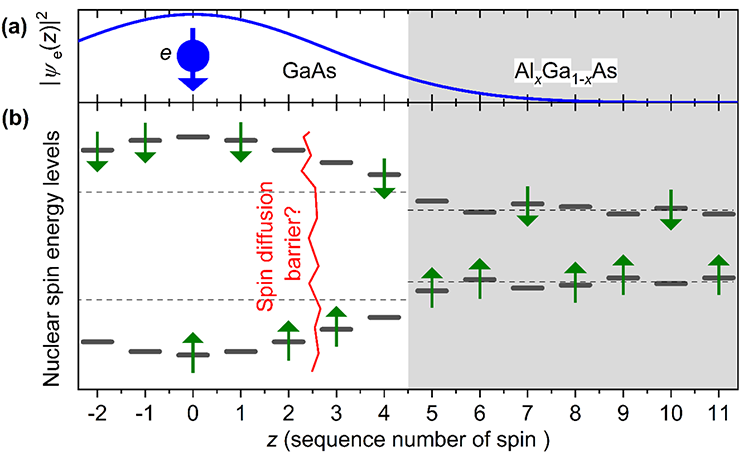
Schematic of a 1D central spin model. The spin of the central electron (a) generates an inhomogeneous magnetic (Knight) field, which is proportional to the electron wavefunction density |ψ e|². The Knight field leads to inhomogeneous shifts of the nuclear spin energies (b) modifying the spin diffusion dynamics. For details see Nature Communications 14, 2677 (2023).
Keeping nuclear spins coherent in presence of an electron spin qubit
It was commonly assumed that as soon as semiconductor quantum dot is charge, the large magnetic moment of the electron quickly destroys any quantum coherence held by the small nuclear spin magnetic moments of the crystal lattice. Our experiments disprove this assumption and show that nuclear spin coherence can be preserved in a carefully design semiconductor device. Achieving long coherence allows us to use nuclei as a sensor for quantum non-demolition measurement of the electron spin qubit with very high fidelity.
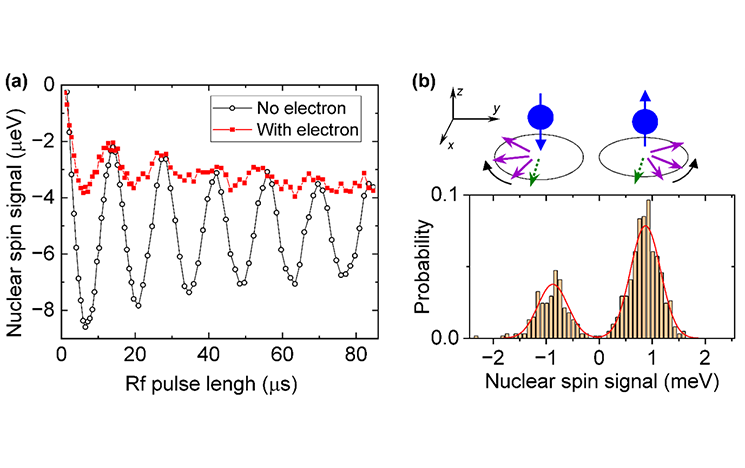
(a) Coherent precession of nuclear spins in an empty and electron-charged quantum dot. (b) Quantum non-demolition measurement of a single electron spin qubit: depending on the electron state the nuclei rotate in a positive or negative direction, resulting in a positive or negative change in nuclear spin magnetization. For details see Nature Communications 13, 4048 (2022).
Prototype two-qubit quantum processor running on nuclear spins of a quantum dot
Over the past two decades nuclear spins were largely viewed as an unsolvable problem of the III-V semiconductor quantum dots. We show that the spin-3/2 quadrupolar nuclei in a quantum dot can be engineered into a "clean" nanoscale quantum system. We demonstrate experimentally the entire toolkit of quantum information processing, including implementation of benchmark quantum computing algorithms.
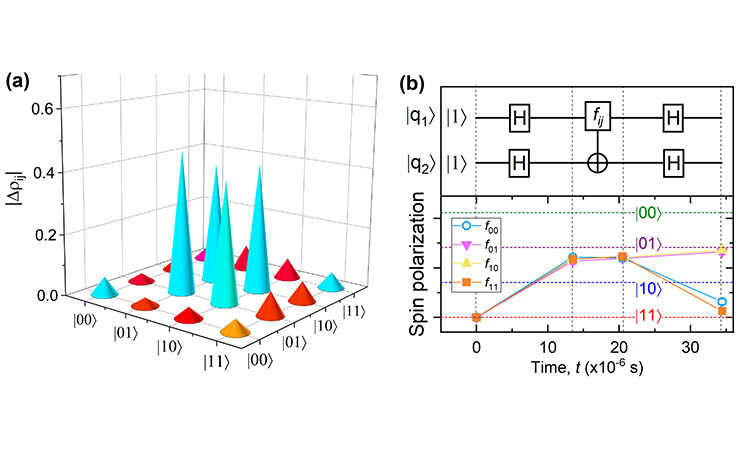
(a) Quantum state tomography of a density matrix of a Bell state in a 2-qubit nuclear spin processor. (b) Deutsch-Jozsa algorithm (top) and implementation (bottom) monitored by optical readout of the processor state. For details see Nature Nanotechnology 15, 999 (2020).
Emergent quantum thermodynamics in a system of interacting nuclear spins
Preserving quantum coherence over long timescales is a key requirement for quantum information processing applications. Here we develop pulse control sequences for dynamical preservation of the coherence and test these sequences on a nuclear spin ensemble of a semiconductor quantum dot. We discover the distinct regimes of decoherence depending on the type of the spin bath: for homogeneous spin baths the coherence storage time can be extended by orders of magnitude, whereas for inhomogeneous (strongly disordered) spin baths the coherence is found to be fundamentally limited by the irreversible conversion of coherence into the many-body spin-spin quantum entanglement. The effect is similar to the second law of thermodynamics, where useful energy is irreversibly converted into wasteful heat, demonstrating emergence of thermodynamic effects in a nanoscale system.
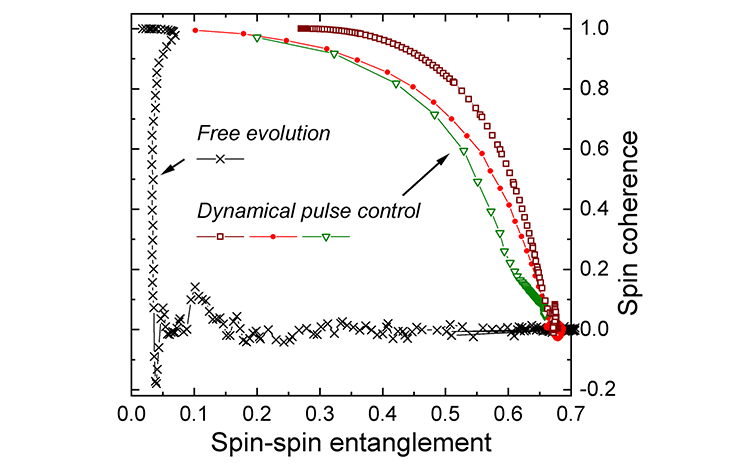
Under free evolution the coherence is lost quickly, but such decoherence can be significantly slowed down by applying dynamical pulse control sequences, so that decoherence is ultimately governed by the emergence of the multipartite entanglement in a many-body spin system. For details see Nature Communications 10, 3157 (2019).
Nuclear spin effects in CdTe/ZnTe quantum dots
The group II-VI semiconductors offer a unique combination of attractive properties: direct-bandgap character offers a good interface between electron spin qubits and photons, while most nuclei are spin-free, suppressing the source of spin qubit decoherence that plagues the group III-V semiconductors. Previous studies of nuclear spins in II-VI quantum dots relied on indirect detection, leaving beyond reach the most interesting regime of strong magnetic fields (>0.1 T). Here we achieve direct detection of the hyperfine shifts in individual CdTe dots and demonstrate fast optical initialization, long lifetimes and radio-frequency manipulation of the nuclear spin magnetization. Our studies highlight II-VI semiconductor quantum dots as a promising platform for hybrid electron-nuclear spin qubit registers, otherwise not achievable in III-V materials.
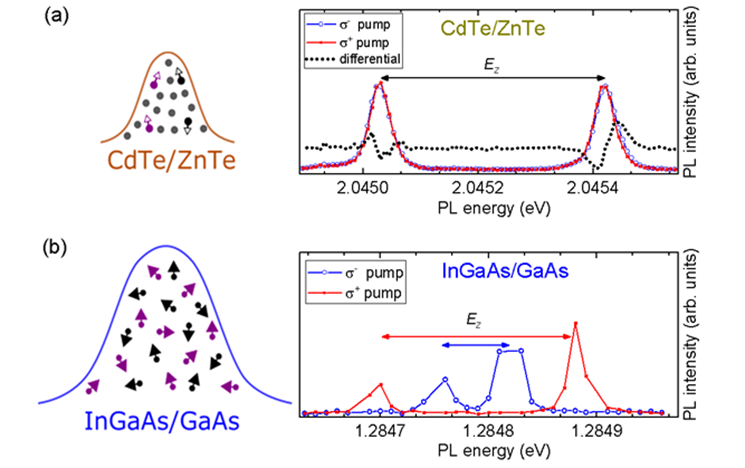
(a) In CdTe/ZnTe quantum dots most nuclei are spin-free resulting in a very small nuclear spin hyperfine field detected in a differential photoluminescence spectrum. (b) For comparison, all group-III and group-V nuclei have non-zero spins resulting in a pronounced hyperfine shift, observed as a large change in the Zeeman splitting of an InGaAs/GaAs quantum dot under circularly polarized optical excitation. For details see Phys. Rev. Lett. 122, 096801 (2019).
Nuclear spin thermometry in quantum dots
Previous measurements of the state of a quantum dot nuclear spin ensemble were limited to mean-field approaches, which lack accuracy due to the spatial inhomogeneity of the nuclear spin polarization and the uncertainty in hyperfine constants. We have developed an alternative NMR-based approach where the state of the nuclear spin ensemble is probed directly by measuring its spin temperature. Our studies lead to observation of record-high nuclear spin polarization in a quantum dot (~80%), reveal the non-equilibrium nature of the optically-cooled nuclei, and allow the hyperfine constants of GaAs to be measured for the first time.
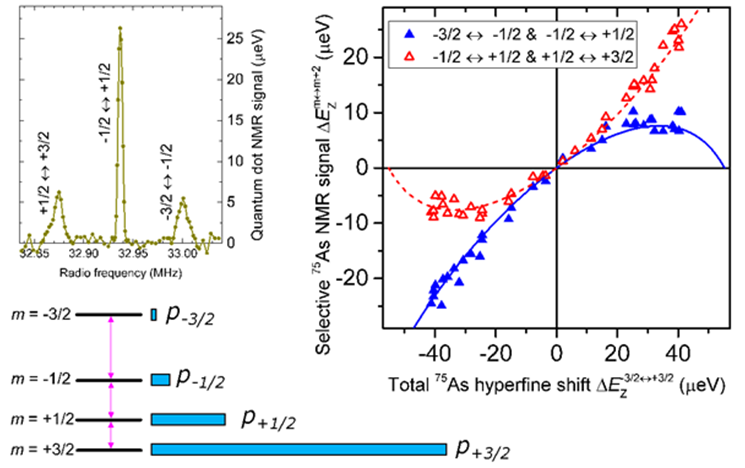
A nuclear magnetic resonance (NMR) spectrum with a well-resolved triplet (top left) originating from the non-equidistant spin levels (bottom left) of the spin-3/2 nuclei in a weakly strained GaAs/AlGaAs quantum dot. NMR signals obtained by selectively saturating two out of three NMR transitions show nonlinear dependence on the initial polarization (right): model fitting of the data allows reconstruction of the nuclear spin level populations (horizontal bars in the bottom left schematic) and a direct measurement of the nuclear spin temperature. For details see Nature Materials 16, 982 (2017).